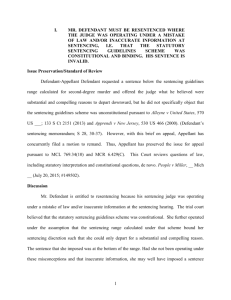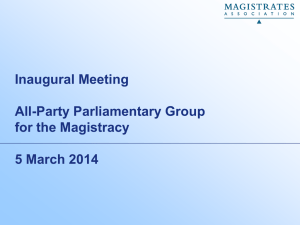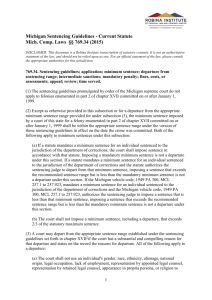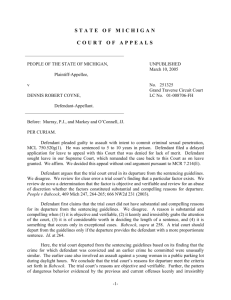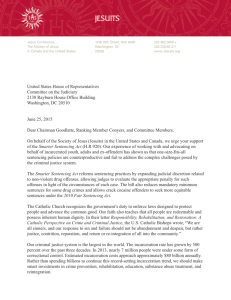People v Alexander Jeremy Steanhouse
advertisement
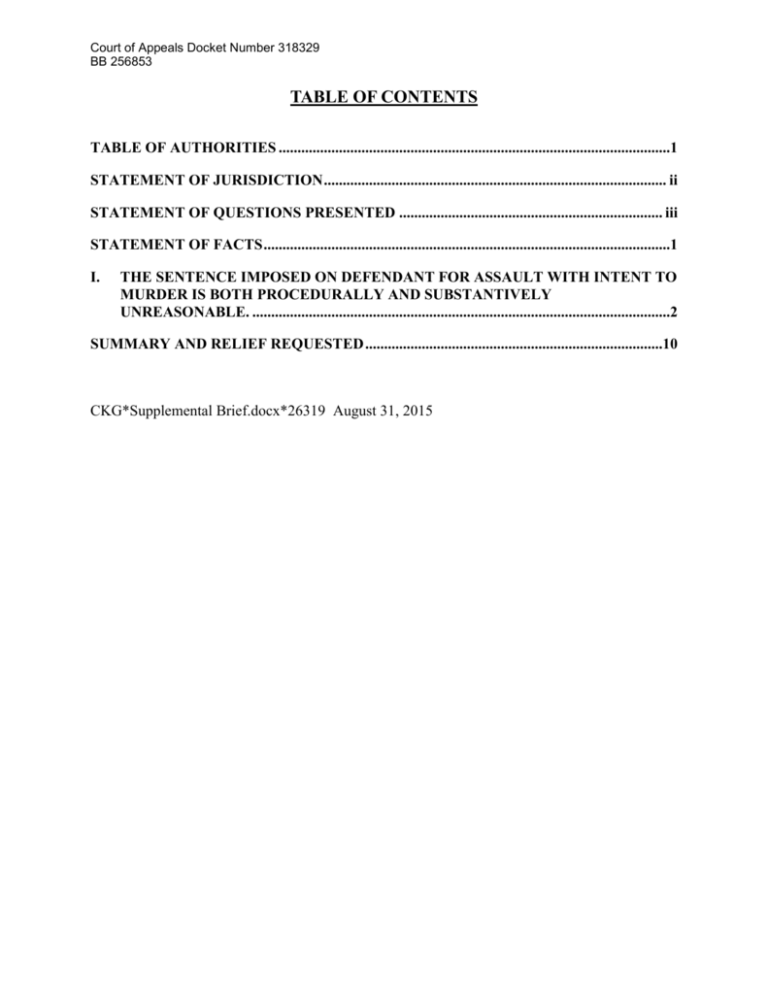
Court of Appeals Docket Number 318329 BB 256853 TABLE OF CONTENTS TABLE OF AUTHORITIES ........................................................................................................1 STATEMENT OF JURISDICTION ........................................................................................... ii STATEMENT OF QUESTIONS PRESENTED ...................................................................... iii STATEMENT OF FACTS ............................................................................................................1 I. THE SENTENCE IMPOSED ON DEFENDANT FOR ASSAULT WITH INTENT TO MURDER IS BOTH PROCEDURALLY AND SUBSTANTIVELY UNREASONABLE. ...............................................................................................................2 SUMMARY AND RELIEF REQUESTED ...............................................................................10 CKG*Supplemental Brief.docx*26319 August 31, 2015 TABLE OF AUTHORITIES Cases Gall v United States, 552 US 38 ......................................................................................... 2, 4, 5, 7 People v Hicks, 259 Mich App 518, 675 NW2d 599 (2003) .......................................................... 7 United States v Booker, 543 US 220, 125 SCt 738, 160 LEd2d 621 (2004) .............................. 2, 9 United States v Castillo, 695 F3d 672 (CA 7, 2012) ...................................................................... 5 United States v Hall, 610 F3d 727 (DC Cir. 2010) ......................................................................... 5 United States v LaSalle, 948 F2d 215 (CA 6, 1991) ....................................................................... 4 United States v Parker, 912 F2d 156 (CA 6, 1990) ........................................................................ 4 United States v Poynter, 495 F3d 349 (CA 6, 2007) ...................................................................... 4 United States v Simmons, 501 F3d 620 (CA 6 2007) ..................................................................... 4 Statutes 18 USC 3553(a) .......................................................................................................................... 2, 5 MCL 750.34 .................................................................................................................................... 8 MCL 769.34(2) ............................................................................................................................... 8 MCL 769.34(3) ........................................................................................................................... 8, 9 MCL 769.34(3)(b)................................................................................................................... 7, 8, 9 MCL 777.22(1) ............................................................................................................................... 6 i STATEMENT OF JURISDICTION Defendant-Appellant was convicted in the Wayne County Circuit Court by jury trial and a Judgment of Sentence was entered on May 31, 2012. A Claim of Appeal was filed on September 18, 2013 by the trial court pursuant to the indigent defendant's request for the appointment of appellate counsel dated August 28, 2012, as authorized by MCR 6.425(F)(3). This Court has jurisdiction in this appeal as of right provided for by Mich Const 1963, art 1, §20, pursuant to MCL 600.308(1); MCL 770.3; MCR 7.203(A), MCR 7.204(A)(2). ii STATEMENT OF QUESTIONS PRESENTED I. WHETHER THE SENTENCE IMPOSED ON DEFENDANT FOR ASSAULT WITH INTENT TO MURDER IS BOTH PROCEDURALLY AND SUBSTANTIVELY UNREASONABLE. Trial Court made no answer. Defendant-Appellant answers, "Yes". iii STATEMENT OF FACTS Defendant adopts the Statement of Facts in the Brief on Appeal. He was sentenced to 30 to 60 years in prison for assault with intent to murder, and one to five years for receiving and concealing stolen property under $20,000. The Court of Appeals issued an order allowing Defendant to file a supplemental brief addressing whether the sentences were reasonable in light of the Michigan Supreme Court’s decision in People v Lockridge, ___Mich___(#149073, July 29, 2015). 1 I. THE SENTENCE IMPOSED ON DEFENDANT FOR ASSAULT WITH INTENT TO MURDER IS BOTH PROCEDURALLY AND SUBSTANTIVELY UNREASONABLE. Standard of Review Because the Guidelines are now advisory, appellate review of sentencing decisions is limited to determining whether they are “reasonable,” United States v Booker, 543 US 220, 125 SCt 738, 160 LEd2d 621 (2004), and an abuse-of-discretion standard applies to appellate review of sentencing decisions. Gall v United States, 552 US 38; 128 S Ct 586, 590; 169 L Ed 2d 445 (2007); People v Lockridge, ___Mich___(#149073, July 29, 2015). Reasonableness The federal guidelines have been advisory, pursuant to United States v Booker, supra, for several years, and the appellate courts accordingly review sentences for reasonableness. When imposing sentence, the federal district courts start by applying the factors delineated in 18 USC 3553(a). Those factors include the following: (a) Factors To Be Considered in Imposing a Sentence. The court shall impose a sentence sufficient, but not greater than necessary, to comply with the purposes set forth in paragraph (2) of this subsection. The court, in determining the particular sentence to be imposed, shall consider: (1) the nature and circumstances of the offense and the history and characteristics of the defendant; (2) the need for the sentence imposed (A) to reflect the seriousness of the offense, to promote respect for the law, and to provide just punishment for the offense; (B) to afford adequate deterrence to criminal conduct; (C) to protect the public from further crimes of the defendant; and 2 (D) to provide the defendant with needed educational or vocational training, medical care, or other correctional treatment in the most effective manner; (3) the kinds of sentences available; (4) the kinds of sentence and the sentencing range established for— (A) the applicable category of offense committed by the applicable category of defendant as set forth in the guidelines— (i) issued by the Sentencing Commission pursuant to section 994 (a)(1) of title 28, United States Code, subject to any amendments made to such guidelines by act of Congress (regardless of whether such amendments have yet to be incorporated by the Sentencing Commission into amendments issued under section 994 (p) of title 28); and (ii) that, except as provided in section 3742 (g), are in effect on the date the defendant is sentenced; or (B) in the case of a violation of probation or supervised release, the applicable guidelines or policy statements issued by the Sentencing Commission pursuant to section 994 (a)(3) of title 28, United States Code, taking into account any amendments made to such guidelines or policy statements by act of Congress (regardless of whether such amendments have yet to be incorporated by the Sentencing Commission into amendments issued under section 994 (p) of title 28); (5) any pertinent policy statement— (A) issued by the Sentencing Commission pursuant to section 994 (a)(2) of title 28, United States Code, subject to any amendments made to such policy statement by act of Congress (regardless of whether such amendments have yet to be incorporated by the Sentencing Commission into amendments issued under section 994 (p) of title 28); and (B) that, except as provided in section 3742 (g), is in effect on the date the defendant is sentenced. [1] (6) the need to avoid unwarranted sentence disparities among defendants with similar records who have been found guilty of similar conduct; and 3 (7) the need to provide restitution to any victims of the offense. Subsection 3553(a)(6) is concerned with national disparities among the many defendants with similar criminal backgrounds convicted of similar criminal conduct. See United States v Poynter, 495 F3d 349, 351-56 (CA 6, 2007); United States v LaSalle, 948 F2d 215, 218 (CA 6, 1991); United States v Parker, 912 F2d 156, 158 (CA 6, 1990); United States v Simmons, 501 F3d 620, 623 (CA 6 2007). In Gall v United States, supra, the Supreme Court made clear that reasonableness review is a two-step process in which the courts of appeals first consider procedural reasonableness by determining whether the sentencing court correctly determined the guideline range, properly considered the §3553(a) factors, and sufficiently explained the sentence imposed; and then consider the substantive reasonableness of the sentence. The first step is “to ensure that the district court committed no significant procedural error, such as failing to calculate (or improperly calculating) the Guidelines range, treating the Guidelines as mandatory, failing to consider the § 3553(a) factors, selecting a sentence based on clearly erroneous facts, or failing to adequately explain the chosen sentence.” “Assuming that the district court’s sentencing decision is procedurally sound, the appellate court,” as a second step, should then consider the substantive reasonableness of the sentence imposed under an abuse-of-discretion standard,” taking into account “the totality of the circumstances.” The Court in Gall also addressed whether the standard of review is heightened depending on how far outside the guideline range the sentence falls. The Court stated that it is “clear that a district judge must give serious consideration to the extent of any departure from the Guidelines and must explain his conclusion that an unusually lenient or an unusually harsh sentence is appropriate in a particular case with sufficient justifications.” If a court chooses a sentence 4 outside the guideline range, the court “must consider the extent of the deviation and ensure that the justification is sufficiently compelling to support the degree of the variance” and must provide an explanation sufficient “to allow for meaningful appellate review and to promote the perception of fair sentencing.” If [the sentencing judge] decides that an outside-Guidelines sentence is warranted, he must consider the extent of the deviation and ensure that the justification is sufficiently compelling to support the degree of the variance. We find it uncontroversial that a major departure should be supported by a more significant justification than a minor one. After settling on the appropriate sentence, he must adequately explain the chosen sentence to allow for meaningful appellate review and to promote the perception of fair sentencing. Gall, supra at 50. Furthermore when a judge varies in a “mine-run case” based “solely on the judge’s view that the Guidelines range ‘fails properly to reflect § 3553(a) considerations,’” closer review may be in order. As the Court acknowledged in United States v Castillo, 695 F3d 672 (CA 7, 2012), “the farther the judge’s sentence departs from the guidelines . . . the more compelling the justification based on factors in section 3553(a) that the judge must offer to enable the court of appeals to assess the reasonableness of the sentence imposed.” Some appellate courts have faulted sentencing courts for failing to explain why it is not imposing a certain sentence proposed by either the government or the defendant. For example, in United States v Hall, 610 F3d 727, 745 (DC Cir. 2010), the District of Columbia Circuit reversed a within range sentence where, among other things, “the district court did not explain why, in view of the factors in 18 U.S.C. § 3553(a), a sentence of 188 months was necessary, much less why the lower sentence that Hall requested would be insufficient. Defendant’s Sentence Is Unreasonable 5 The sentencing guidelines, as scored, recommended a minimum sentence of 171 to 285 months. The trial court departed from the guidelines and imposed a sentence of 30 to 60 years in prison, stating the following reasons for departure: [T]he first two factors that the prosecutor mentions the horrendous, brutal assault on this young man when basically appeared by the facts that you thought he was somehow rendered weak or incapacitated by his drug use at that time. And the action taken by you towards a person who considers you a friend does substantiate the thought that you are a person without a conscience, a person who’s violent and depraved and that this is an assault that is quite shocking even to people who have been in the courts for 20 and more years. (ST 36). The sentence is not procedurally reasonable. The guidelines were not scored accurately. OV 6 was erroneously scored at 50 points. As the statute reads, only when there is an actual killing in a circumstance in which the crime would have been a felony-murder is the intent which can support such a conviction sufficient for a scoring of fifty points. The trial court erred in finding that a score of 50 could be imposed if the assault occurred during an attempted larceny. Where the conviction crime, as here, is assault with intent to commit murder, the scoring depends on whether the accused had a premeditated or unpremeditated intent to kill, and the trial court erred in finding that Mr. Defendant premeditated a plan to murder. The charged assault with intent to murder was spontaneous and not part of a premeditated plan to murder by Mr. Defendant. There is no record support for the scoring of OV 5. Being “deeply affected” by the incident does not constitute “serious psychological injury” under the statute. Just as “excessive” modifies “brutality” in OV 7, “serious” modifies “psychological injury” in OV 5. Not just any psychological injury may be scored, only serious ones. OV 5 may only be scored in homicide offenses or, recently, assault with intent to murder. MCL 777.22(1). In context, the statute 6 recognizes that psychological injury to the decedent’s family is often a characteristic of homicide offenses and that some people may suffer it at a serious level that may require treatment. It is only at that serious level that points are assessed. Here, OV 5 should not have been scored as there was no indication that the decedent’s family suffered serious psychological harm that may require professional treatment, even if it were true that “we’re ..in the process of getting psychological help for what happened.” People v Hicks, 259 Mich App 518, 534-535, 675 NW2d 599 (2003). The sentence is also substantively unreasonable. According to Gall, supra, the trial court “must consider the extent of the deviation and ensure that the justification is sufficiently compelling to support the degree of the variance.” The judge’s opinion that Mr. Defendant had no conscience because the victim was his friend was purely subjective, as was the judge’s opinion that the victim was “weakened” by his voluntary act of smoking marijuana (a daily habit for Mr. Valoppi). Likewise, Defendant’s alleged lack of conscience and depravity are purely subjective and internal to the mind of the judge. These reasons reflect the judge’s personal opinion about the character of the defendant rather than facts that are capable of being evaluated and confirmed by an appellate court. These reasons are not compelling. The “horrendous” nature of the offense was a factor already scored in the guidelines. [See argument below that MCL 769.34(3)(b) remains valid.] Mr. Defendant was given a total of 130 points for the victim having been cut with a knife, for the kind of weapon used, for lifethreatening injury to the victim, for psychological injury to the victim and his family, and for premeditated murder. The trial court did not explain how the nature of the crime was given inadequate weight in the guidelines scoring. Moreover, the judge specifically found that Mr. Defendant did not use excessive brutality when the judge refused to score Defendant under OV 7 7 (aggravated physical abuse). The fact that the court found insufficient evidence of excessive brutality and refused to impose a score under that offense variable, but turned around and departed from the guidelines based on the same facts demonstrates the unreasonableness of the sentence imposed. Mr. Valoppi sustained a life-threatening injury, but, again, all of the relevant circumstances were taken into account in scoring the guidelines. The trial court also failed to explain the extent of the departure. The trial court failed to impose a sentence that was “sufficient, but not greater than necessary” to achieve the goals of sentencing. Validity of MCL 769.34(3)(b) MCL 769.34(3) subsections (a) and (b) state the following: (3) A court may depart from the appropriate sentence range established under the sentencing guidelines set forth in chapter XVII if the court has a substantial and compelling reason for that departure and states on the record the reasons for departure. All of the following apply to a departure: (a) The court shall not use an individual's gender, race, ethnicity, alienage, national origin, legal occupation, lack of employment, representation by appointed legal counsel, representation by retained legal counsel, appearance in propria persona, or religion to depart from the appropriate sentence range. (b) The court shall not base a departure on an offense characteristic or offender characteristic already taken into account in determining the appropriate sentence range unless the court finds from the facts contained in the court record, including the presentence investigation report, that the characteristic has been given inadequate or disproportionate weight. While the Supreme Court in People v Lockridge, supra, struck down as unconstitutional the provision in MCL 769.34 that requires a substantial and compelling reason to depart from the Guidelines, the Court did not strike sections 3(a) or 3(b). The Court noted, specifically, that it was especially interested in doing “the least judicial rewriting of the statute[.]” (p. 28). Therefore, the Court merely substituted “may” for “shall” in MCL 769.34(2) and removed the 8 requirement in MCL 769.34(3) that a trial court must state a substantial and compelling reason for departure. The Court did not disturb the intent of Legislature to prevent use of improper ethnic and similar considerations, or to prevent double-counting by using reasons already calculated in the guidelines range to justify a departure. Furthermore, the Supreme Court held that the sentencing guidelines remain a “highly relevant consideration in a trial court’s exercise of sentencing discretion,” and, therefore, held that trial courts “’must consult those Guidelines and take them into account when sentencing.’” (Quoting Booker, 543 US at 264.) The Court in Lockridge emphasized that the goal of the sentencing guidelines, both in Michigan and in the federal courts, is to eliminate disparity in sentencing. Holding that trial courts must consult the Guidelines, the Court said: Such a system, while ‘not the system [the legislature] enacted, nonetheless continue[s] to move sentencing in [the legislature’s] preferred direction, helping to avoid excessive sentencing disparities while maintaining flexibility sufficient to individualize sentences where necessary.’” Lockridge, p. 29 (quoting Booker, supra at 264265) (emphasis added). Sections 34(3)(a) and (b) are important tools for preventing sentencing disparities. For example, if a trial court is allowed to depart upward for reasons already taken into account in the sentencing variables, the resulting sentence is going to be higher than that for a similarly situated defendant. On the other hand, if the Guidelines gave a certain factor inadequate weight, the trial court is free to base a departure on that factor. The statute [MCL 769.34(3)(b)] therefore has trial court discretion built into it, and it remains valid after Lockridge. 9 SUMMARY AND RELIEF REQUESTED WHEREFORE, for the foregoing reasons, Defendant-Appellant asks that this Honorable Court find his sentence unreasonably excessive and remand for resentencing. Respectfully submitted, STATE APPELLATE DEFENDER OFFICE /s/ Chari K. Grove BY:________________________________________ CHARI K. GROVE (P25812) Assistant Defender 3300 Penobscot Building 645 Griswold Detroit, Michigan 48226 (313) 256-9833 Dated: August 31, 2015 10


